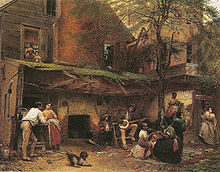Eastman Johnson
Jonathan Eastman Johnson (born July 29, 1824 in Lovell , Maine , † April 5, 1906 in New York City ) was an American painter of the 19th century. He was best known for his portrait and landscape painting and was one of the first American artists of his era to receive extensive training in Europe.
life and work
Eastman Johnson was born in 1824 as the eighth and last child of Philip Carrigan Johnson (Secretary of the State of Maine after 1840) and his wife Mary Kimball Chandler in Oxford County , Maine, and grew up near Fryeburg . In 1834 he moved with his parents to Augusta , where his father worked as an employee of the state government. In 1840 he began a two-year apprenticeship in the lithography business of JH Bufford in Boston , then from 1842 to 1845 he was a traveling portrait artist in New England and Washington, DC and from 1846 to 1849 he worked as a portraitist in Boston with the support of the family of Henry Wadsworth Longfellow . He drew well-known personalities of his time such as Dolley Madison and John Quincy Adams .
Protected by the American Art Union in New York City , Johnson came to Germany with George Henry Hall in 1849 and studied in Düsseldorf at the art academy there with Heinrich Mücke until 1851 . He took private lessons from Emanuel Leutze . From 1850 to 1852 he was a member of the Düsseldorf artist association Malkasten . In 1851 he traveled to London for the Great Exhibition at Crystal Palace ; He then lived from 1851 to 1855 in The Hague , where he was supported primarily by the American ambassador August Belmont . In 1855 he studied with Thomas Couture in Paris for a few months before returning to America due to the death of his mother.
Between 1855 and 1859 he traveled a. a. to Washington DC, Cincinnati and Superior in Wisconsin , where he also painted Indians of the Chippewa tribe. In 1859 he set up his studio in New York City. In 1859 he became known because of the exhibition of the work Negro Life at the South at the New York Historical Society and he became an associate member ( ANA ), then in 1860 a full member ( NA ) of the National Academy of Design in New York, where he was until 1869 taught. In the following years he traveled to Maine and from 1870 spent his summers in Nantucket , Massachusetts . He mainly painted interiors and rural motifs. Further trips to Europe took place in 1885 and 1897. Johnson was also active in several associations, especially the National Academy, the Century Club and the Union League Club, the Metropolitan Museum of Art , which he helped found, and the Society of American Artists . After 1880, however, he devoted himself almost exclusively to portraiture.
style
Johnson initially cultivated a clear and detailed painting style reminiscent of the work of George Charles Bingham and William Sidney Mount . At the beginning of the 1870s, he also developed a more sketchy technique, which he used primarily in landscape painting.
Image selection
The Girl I Left Behind Me , 1875
Individual evidence
- ↑ nationalacademy.org: Past Academicians "J" / Johnson, Eastman NA 1860 ( Memento of the original from April 2, 2015 in the Internet Archive ) Info: The archive link was inserted automatically and has not yet been checked. Please check the original and archive link according to the instructions and then remove this notice. (accessed June 27, 2015)
literature
- Thomas W. Gaethgens: Pictures from the New World. American painting of the 18th and 19th centuries Prestel, Munich 1988, ISBN 3-7913-0879-3 , p. 311.
- Stephan Koja: America. The New World in 19th Century Pictures. Prestel, Munich 1999, ISBN 3-7913-2051-3 , pp. 180-181 and p. 264.
Web links
- Eastman Johnson in the database of Find a Grave (English)
- Johnson in the Artcyclopedia
- Eastman Johnson in the American National Biography Online
| personal data | |
|---|---|
| SURNAME | Johnson, Eastman |
| ALTERNATIVE NAMES | Johnson, Jonathan Eastman (maiden name) |
| BRIEF DESCRIPTION | American painter |
| DATE OF BIRTH | July 29, 1824 |
| PLACE OF BIRTH | Lovell , Maine |
| DATE OF DEATH | April 5, 1906 |
| Place of death | New York City |





